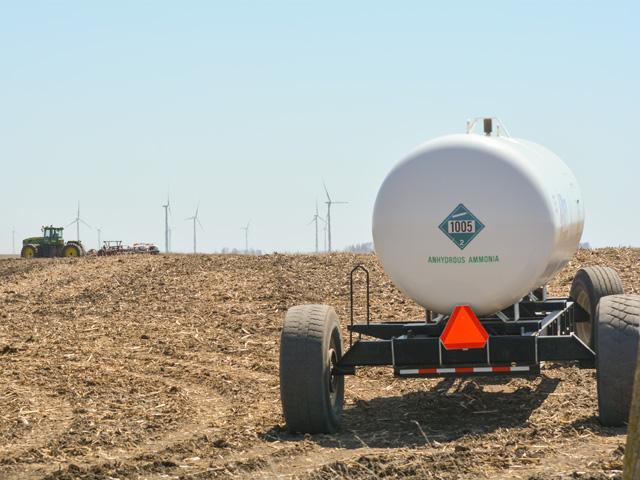Higher Prices Ahead for Inputs
Economist Sees Little Relief for Fertilizer, Fuel Prices
OMAHA (DTN) -- The price outlook for both fertilizer and fuel is not very optimistic, according to a Kansas State University (KSU) agricultural economist Gregg Ibendahl.
In a webinar last week, Ibendahl said both inputs have major issues to overcome before either market will see less expensive prices.
Fertilizers show the potential for even higher prices based on several different factors despite recent records at the retail level. Fuel, meanwhile, has major supply issues with fewer U.S. refineries in business with no new facilities planned.
$2,000/TON ANHYDROUS?
Ibendahl uses a modeling system to predict where retail fertilizer prices could go, using the price of corn, price of oil and inflation to come up with an anhydrous price.
Based on oil at $125/gallon, a $7.00/bushel corn price and 8% inflation, the model's average price for anhydrous in 2022 should be in the $1,700/ton range, he said.
Anhydrous climbing to $2,000/ton is not out of the question. Ibendahl said it would not be surprising "at all" if prices climbed to new all-time highs.
"Farmers should be prepared and be planning for this," he said.
The model also predicted potash prices could rise to $1,200/ton, while MAP prices could be in the $1,470/ton range, he said.
For some perspective, the highest average retail fertilizer price tracked by DTN for anhydrous this spring was $1,534/ton. For potash prices, the high point was set at $881/ton, while MAP peaked at $1,083/ton.
Retail fertilizer prices for the third week of June 2022 were mainly lower, with one fertilizer significantly lower (https://www.dtnpf.com/…).
P[L1] D[0x0] M[300x250] OOP[F] ADUNIT[] T[]
Many farmers cut back on phosphate and potash applications this growing season to tighten their fertilizer budgets. While a good strategy short-term, at some point yields will suffer, and thus farmers will have to begin to apply these nutrients once again sometime soon, Ibendahl said.
POTASH PRICES COULD INCREASE
Ibendahl said he is especially concerned about the potash (K) prices. While the U.S. is somewhat self-sufficient in producing nitrogen and phosphorus fertilizers, most of the K imported into the U.S. comes from Canada. Even these imports are still subject to world geopolitical situations, such as the Ukraine and Russia military conflict.
Because of this, he said K prices could be subject to large increases in the near future.
"Potash may be underpriced relative to anhydrous before the conflict," he said. "There could be a big jump coming for potash prices."
FUEL PRICES CLIMBING BEFORE WAR
Most people are blaming the Ukraine-Russia military conflict for the higher fuel prices, but Ibendahl is quick to point out prices were climbing before the war. A 50% to 60% increase in fuel prices happened before the fighting began in Ukraine, he said.
Diesel prices rose first, but gasoline prices climbed quickly in recent months. The normal diesel-gasoline price spread is 25 to 50 cents/gallon, and today it is about $1.00/gallon, he said.
The U.S. Energy Information Administration (EIA) predicts a recovery in fuel prices could come in the fall. Based on $120/barrel oil prices and a normal price relationship of gas and diesel, Ibendahl said highway diesel prices should be near $4.60/gallon and gasoline prices should be $4.25/gallon.
"Why are we at these levels?" Ibendahl asked. "It is refinery capacity."
FUEL SUPPLY LOW
During the beginning of the COVID-19 pandemic, fuel demand fell off a cliff as the world closed. Some refineries went offline, he said. Now, with people feeling the need to travel after a couple of years of COVID lockdowns, fuel supply can't keep with demand as several refineries never reopened.
Ibendahl pointed to a couple examples of refineries that never reopened. One was near Philadelphia, which closed because of a fire, and another one was in Louisiana. This plant was closed because of damage from Hurricane Ida.
U.S. oil refineries are operating at a very efficient 90% to 95% utilization rate, but this still doesn't make up for lower capacity. The nation hasn't seen a new oil refinery open since 1977, he said.
Ibendahl said companies are not willing to build modern oil refineries in the U.S. for several different reasons. The overall cost, issues with the red tape for environmental concerns and a current administration that isn't a big fan of fossil fuels combine to limit the interest in building oil refineries in the country.
"I'm not very optimistic we will see lower prices until we see more refinery capacity, and this does not appear to be very likely," he said.
POSSIBLE RECESSION
Ibendahl said the effects of high fuel prices could lead the U.S. economy to a major recession, something he feels is a real possibility.
If a recession did occur, prices for both fuels and fertilizer would drop alongside other commodity prices. Some ag analysts feel this situation could lead to another farm financial crisis, he said.
Old enough to remember the 1980s farm crisis, Ibendahl said there are some similarities and differences to the events that happened 40 years ago. Rising inflation and a possible drop in commodity prices would be similarities.
"I think the difference would be farmers today generally have a much less debt load than they in the 1980s," Ibendahl said. "But a major recession could lead to something like this."
Russ Quinn can be reached at Russ.Quinn@dtn.com
Follow him on Twitter @RussQuinnDTN
(c) Copyright 2022 DTN, LLC. All rights reserved.





